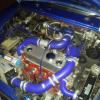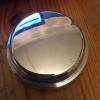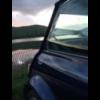
Valve Guides Made Too Small?
#1

Posted 25 July 2011 - 07:23 PM
The only thing I can think of is the so called machine shop that pressed the guides in just hammered them in or something or the guides are dodgy.
Any ideas?
#2

Posted 25 July 2011 - 07:34 PM
#3

Posted 25 July 2011 - 07:47 PM
Never used a reamer before but how hard can it be lol The idiots haven't even set all the guides level, they're all differnt hights, will this cause problems? they not too far out but a good 2-5mm
Edited by danrock101, 25 July 2011 - 07:49 PM.
#4

Posted 25 July 2011 - 08:40 PM
Press out old... (or whack out)
Press in new to correct height
Ream out inside to correct size
Recut valve seat..
So not really a DIY job.. or one for a general machine shop... best bet is an engine reconditioning/machine shop
#5

Posted 26 July 2011 - 12:44 AM
Edited by danrock101, 26 July 2011 - 12:51 AM.
#6

Posted 26 July 2011 - 02:22 AM
they do engine re-conditioning, they specialise in it, or atleast they advertise that been going a few years too, the aprentices' sister must have done mine
then I think they made up a price by use of a random number generator
Perhaps the quoted the lower price after you complained about the high price and then they intentionally did not ream the guides to make a point with you... if you were haggling with them.
Like icklemini said, the complete seating/lapping of valves after new guides are installed is not a job for most DIY people. I do a lot of parts fabrication and all my own car work but I have NEVER done tasks like installing guides and cutting valve seats.
#7

Posted 26 July 2011 - 01:02 PM
They must be honed at the very least to maintain any useful accuracy and service life.......
Reaming is just not suitable......
#8

Posted 26 July 2011 - 02:57 PM
its how most/all bushes are done. the problem is when people use adjustable reamers.
#9

Posted 26 July 2011 - 03:22 PM
Unfortunately with valve guides they are manufactured to the finished condition and when pressed in reduces by about 0.002" not enough for a reamer.....
Any proper cylinder head remanufacturing company will always use a hone, as this will maintain a straight, parallel and as round as you are likely to ever need it.
reaming guides results in poor surface finishes that will wear quickly and create a smokey engine rather too quickly
Now from an undersize guide with plenty of material in them ie more than 0.006" then a reamer will do the job well..
#10

Posted 27 July 2011 - 10:27 AM
Don't bodge this part of the engine build by using a reamer !!!
They must be honed at the very least to maintain any useful accuracy and service life.......
Reaming is just not suitable......
You say this every time the topic comes up, and i've never seen anyone agree with you...
#11

Posted 27 July 2011 - 11:04 AM
I'm not saying horning isn't good, but Reaming is very suitable as long as you use the correct size
#12

Posted 27 July 2011 - 11:35 AM
Don't bodge this part of the engine build by using a reamer !!!
They must be honed at the very least to maintain any useful accuracy and service life.......
Reaming is just not suitable......
You say this every time the topic comes up, and i've never seen anyone agree with you...
And I will continue to say it, reaming is not suitable.... it is a cheap, less effective method in this case. For instance reaming radius arm bushes is acceptable, because there is enough material in the bush, that is because the radius arm bush is way under size fo rthe radius arm pin and the reamer has enough material to actually cut in to.
A straight reamer is normally to an accuracy of 0.0008" which means theres plenty of material to cut if a valve guide is -0.002"
The accuracy has absolutely nothing to do with how much metal it is required to remove !
its all to do with how a reamer works, a reamer needs to have at least 0.006" to work, if it doesn't then it will bounce around in the hole and create all sorts of issues later on..
I'm not saying horning isn't good, but Reaming is very suitable as long as you use the correct size
Honing if far superior to reaming except that it has to be guaged correctly to get the correct size..... oh and of course the hone is more expensive, so a lot of "so called" engine builders prefer them, it also means that when your engine starts smoking they will probably tell you its your fault for driving it too hard...
Anyone who knows about cutting tools will tell you that certain cutting edges need a certain amount of material to cut otherwise all they do is skip and bounce, and ruin the surface finish.
So in this case reaming is definately a no-no .... however I am not too bothered what you choose to use its your money.... or your customers money anyway.
#13

Posted 27 July 2011 - 12:41 PM
Reaming is a cutting process, just like planing a bit of timber; the material is "wedged" apart in front of the tool's cutting edge and you don't really have any control over where it separates as it will vary with what you are reaming. Also, as Martin said, you need enough material to pick up above your "wedge" for it to work properly.
Honing is akin to grinding, the material is "rubbed" off the surface to the same depth as the tool.
You might manage to ream accurately enough, but there are more factors to control to do it reliably.
#14

Posted 27 July 2011 - 05:50 PM
#15

Posted 27 July 2011 - 05:59 PM
We have had numerous heads in to be rebuilt.... one in particular had only done 200 miles and was smoking very badly, the guides had been reamed and the wear was amazing, we measured 1.6mm at the head when level with the gasket face......
The reamer when used incorrectly will leave vertical lines caused by chatter so actually serve as oil drainage not retention for lubrication
1 user(s) are reading this topic
0 members, 1 guests, 0 anonymous users



















